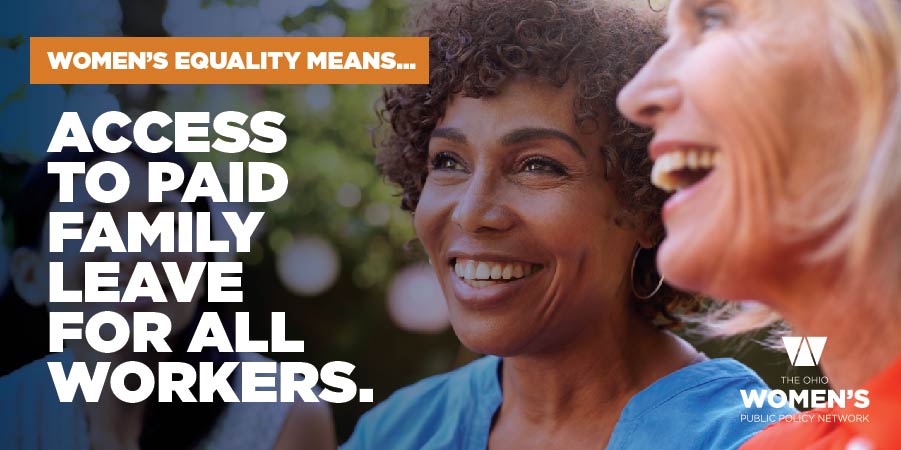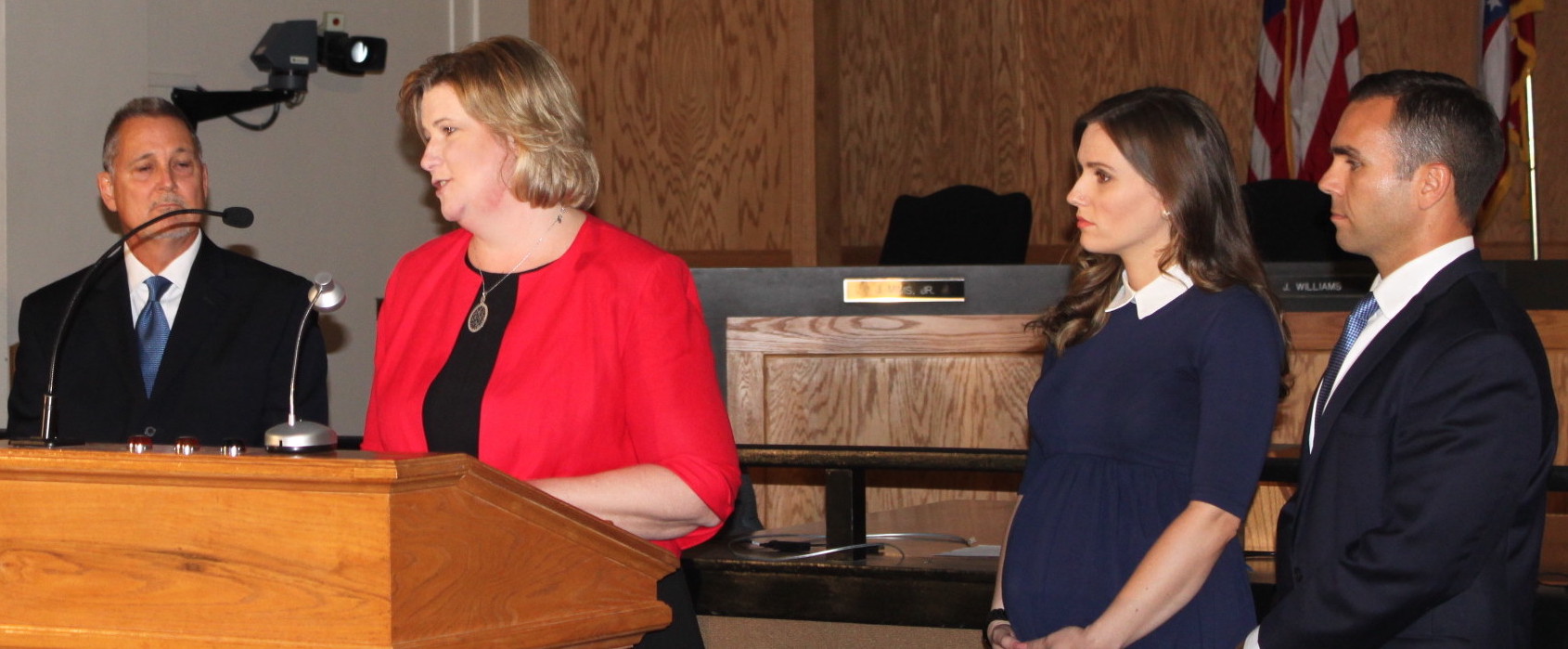Guest Blog by Nan Whaley – Women’s Equality Means…Access to Paid Leave
Sunday, August 26th, 2018
Women’s Equality Means…Access to Paid Leave
Guest Blog By: Dayton Mayor Nan Whaley
Women’s Equality Day
On August 26, 1920, the 19th amendment was adopted into the U.S. Constitution, giving women the right to vote. Now, nearly 100 years later, we recognize this major milestone by celebrating Women’s Equality Day. As we look back on progress made in history, we must also recognize how much further we have to go to achieve true gender equality.
Even after the passage of the 19th amendment, Black women – and men – faced voter disenfranchisement through barriers like poll taxes, literacy tests, and grandfather clauses; implemented to prevent them from voting. And while the Voting Rights Act of 1965 was later passed to counter these barriers and outlaw discriminatory practices, people of color are disproportionately affected by voter suppression laws to this day.
Voting is a powerful way to move the needle on progress, but as a policymaker, I also have the ability to advance gender equality by shaping the policy landscape. That’s why, three years ago today, I announced the introduction of a paid leave policy for municipal workers in Dayton. Taking this step made us the first city in Ohio to enact a stand-alone paid parental leave policy – and this was the start of a groundswell of action on paid leave from local elected officials across the state.
Dayton Mayor Nan Whaley – joined by city workers, advocates, and policy experts – announces the city’s paid parental leave policy on Women’s Equality Day in 2015
Dayton Leads on Leave
The announcement of our city’s paid leave policy aligning with Women’s Equality Day was intentional: paid leave is crucial for gender equality. In the absence of a national paid leave standard, 85 percent of American workers do not have access to paid leave through their employer. And in Ohio, even unpaid leave under the federal Family and Medical Leave Act is inaccessible for 62 percent of working people.[i]
Women – particularly women of color – are disproportionately hurt by the lack of paid leave, and access to the benefit is a fundamental policy to promote gender equality. Women are overrepresented in the part-time, lower-wage and independent contractor workforces, which often do not extend benefits like paid leave to their employees. In fact, nationwide, only four percent of low-wage workers have access to paid leave – compounding economic insecurities of these working families.
Paid leave can also contribute to greater workforce participation for women, benefitting their families’ economic stability and our local economy. In Ohio, there is an 11-percentage point gap in labor force participation between men and women.[ii] This can be partially attributed to the lack of access to paid leave policies as women are more likely to take a leave of absence from their jobs or leave the workforce entirely to take on caregiving duties for children.
Gender and Racial Disparities in Access to Leave
Black women and Latinas are even less likely to have access to paid leave, which makes it more difficult for families of color to grow wealth attainment following a personal or family medical event, such as the birth or adoption of a new child. For generations, discriminatory policies and persistent racism have prevented most women of color from building wealth, which is defined as assets minus debts, and the lack of access to paid family leave exacerbates the wealth gaps and racial disparities among families of color and white families. To put this into context, the average white family has $140,500 in wealth compared to $6,300 for the average Latino family and $3,400 for the average Black family.[iii]
Women of color also face racial disparities in health care access and quality, typically receiving lower quality health care services and experiencing worse health outcomes compared to white women. Nationally, Black women are three to four times more likely to die from pregnancy-related deaths compared to white women. Access to paid leave would play a role in addressing some of these racial disparities in health outcomes, allowing women time to heal, adjust to a new schedule, and attend to follow-up medical needs without facing the financial constraints of taking leave without pay.
Allowing for both men and women to have access to paid leave benefits can contribute to increasing fathers’ active participation in raising the child, which promotes gender equality in the workplace and home. When paid leave access is limited only to maternity leave, child care responsibilities are more likely to fall primarily or solely upon women in the household. Because of this critical role that inclusive paid leave policies play in gender equality, we ensured that Dayton’s policy would be extended to both mothers and fathers following the birth, adoption, or foster placement of a child.
Workers should not have to choose between their economic livelihood and their loved ones, but without access to leave, many workers – especially women – are put into this position. And, when unpaid leave is the only option, it is often a false choice for lower and middle income earners who are unable to afford taking time away from work without earning a paycheck.
Time for Ohio to Lead
Dayton took the lead to provide working parents in our city with the support they need to balance the demands of work and the needs of family; but until a statewide policy is enacted, access to paid leave will depend upon where a person works or lives. Fortunately, state lawmakers have introduced legislation that would address this fundamental need for paid leave Ohio workers are currently facing.
Earlier this year, State Senator Tavares and State Representatives Boyd and Boggs introduced legislation (Senate Bill 261 and House Bill 550) that would create a statewide paid family and medical leave program. This legislation would allow for workers to continue earning a percentage of their paycheck while they take time off of work to:
- Care for and bond with a newborn, newly-adopted child, or newly-placed foster child;
- Care for a family member with a serious health condition; or
- Address one’s own medical health condition
By enacting a paid leave policy for the nearly two thousand city of Dayton employees, we committed to advancing gender equality and took an important step in improving public health, economic growth, and family well-being in our city. It’s past time for Ohio to take these same strides forward by enacting a statewide paid family leave policy. Visit the Women’s Public Policy Network’s Paid Leave Toolkit to learn more about how you can get involved in efforts to make paid leave a reality in Ohio.
[i] http://www.nationalpartnership.org/research-library/work-family/paid-leave/paid-leave-means-a-stronger-ohio.pdf
[ii] Ibid
[iii] http://www.nationalpartnership.org/research-library/work-family/paid-leave/paid-family-and-medical-leave-racial-justice-issue-and-opportunity.pdf
 ABOUT THE AUTHOR: Nan Whaley is proud to have chosen Dayton as her home. Originally from Indiana, Nan attended the University of Dayton and has lived in Dayton ever since. She has resided in the Five Oaks neighborhood since 2001 where she lives with her husband, Sam.
ABOUT THE AUTHOR: Nan Whaley is proud to have chosen Dayton as her home. Originally from Indiana, Nan attended the University of Dayton and has lived in Dayton ever since. She has resided in the Five Oaks neighborhood since 2001 where she lives with her husband, Sam.
Nan’s career is distinguished by her commitment to public service, civic involvement and interest in local government. First elected to the Dayton City Commission in 2005, Nan has also served on the Montgomery County Board of Elections and as a deputy to Montgomery County Auditor Karl Keith. She is a member of Corpus Christi Catholic Church and a graduate of Leadership Miami Valley. She currently serves on Greater Ohio’s Community Revitalization Committee, the Learn to Earn Executive Committee for Education, the Montgomery County Planning Commission, the Dayton Area Chamber of Commerce Board of Trustees, and the Dayton Development Coalition Board of Trustees.
With a focus on jobs and workforce development, Nan is working with a diverse group of business partners to strategically position Dayton for growth. She is the founder of the Dayton Region Manufacturing Task Force; a regional effort committed to advocating for manufacturing and promoting a strong manufacturing workforce. In addition, she meets regularly with local business leadership, both individually and through her Mayor’s Business Round Table meetings.
Nan is committed to strengthening Dayton’s communities through thoughtful and strategic programming. She led the community in creating a county-wide landbank system to address the local housing crisis with a more regional approach and serves on the Montgomery County Landbank Board. As chair of the Bike Walk Dayton Committee, Nan strives for Dayton to become a Bicycle Friendly Community.
Mayor Whaley believes that strong neighborhoods and economic stability can only be achieved through a community-wide focus on education. Nan advocates to ensure that every student in Dayton attends a high performing school that prepares them for the opportunity to attend college, join the military or seek advanced training in a marketable job skill.
In addition, Nan has been committed to the political process in local, state and national elections. She is a three-time delegate to the Democratic National Convention in 2000, 2004 and 2012 and has served as Chief of Staff on the 2011 No on Issue 2 campaign and the Get Out the Vote Director for United States Senator Sherrod Brown in 2012. As an elector for Ohio’s Third Congressional District, Nan proudly cast an electoral vote for President Obama.
Nan has her undergraduate degree in Chemistry from the University of Dayton and received her Master’s of Public Administration from Wright State University where she has served as an Adjunct Professor.
Nan Whaley was elected Mayor by Dayton voters in November of 2013, following two City Commission terms.

